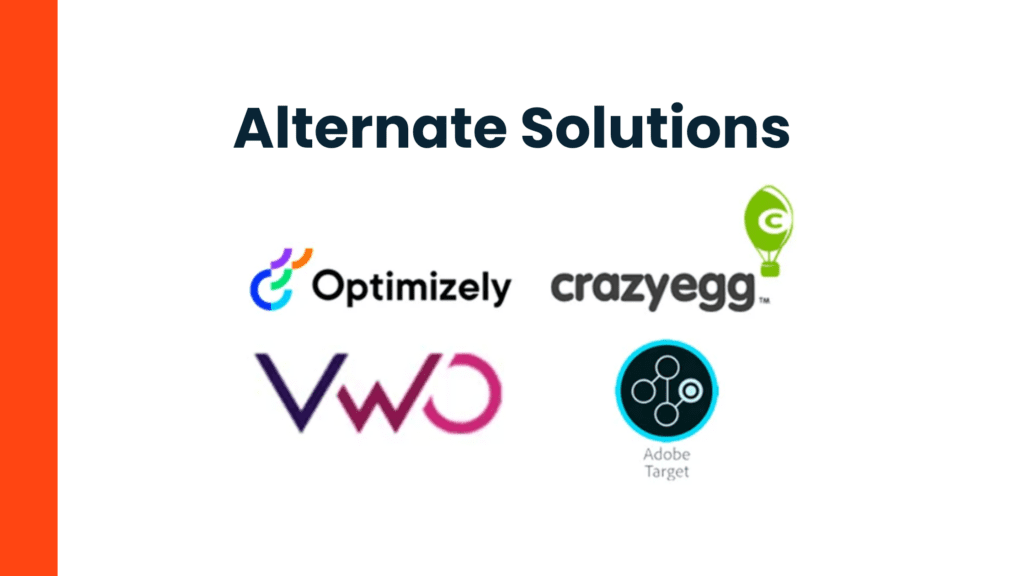Perhaps one of the biggest setbacks for testing marketers is the loss of a free tool. Long gone will be the days of testing and personalization within the Google Suite now that Google has announced that they will discontinue their Google Optimize and Optimize 360 testing and optimization tools on September 30th, 2023.
How Does This Impact Me?
This news might seem like it only impacts UX testing teams, but the effect extends beyond those teams.
Analytics teams should ensure any new testing tools can be reported against and integrated into your current process. This means that you’ll need a team dedicated to building a strategy to anticipate any roadblocks that may arise when transitioning a testing program from one solution to another.
Paid media teams will also feel the ripple of this change, considering there is no other testing tool available at this time that communicates as efficiently and effortlessly as Google Optimize does with Google Ads. Of course, all testing solutions can be integrated with Google Ads and Google Analytics but keeping all ad data and testing data within a single solution will no longer be an option.
How Can I Be Ready?
In a case like this, an analytics team comprised of UX and CRO strategists, digital analysts and a UX and CRO engineer will want to assess:
- your testing program goals
- the current testing velocity
- the complexity of the concluded tests and upcoming tests
- and the ensuring that the testing roadmap can be scaled up if velocity increases.
A CRO Engineer and CRO Strategist will then assess which tools are compatible with your testing program and will consider:
- Will the new tool integrate seamlessly?
- Will test reports be robust enough to inform a marketing strategy?
- Will the tool accommodate for any website nuances that require additional coding to effectively run a test or personalization?
- How will the new tool perform when multiple tests are running at the same time?
Do I Really Need to Test?
It can be extremely detrimental to paid media teams to take a testing hiatus.
Testing strategists and CRO engineers work closely with paid media managers to test ads and landing pages. After all, paid media managers strive to send as much traffic as possible to dedicated landing pages, and without testing on these landing pages, it’s nearly impossible to determine which optimizations will generate the highest on-page conversion rates, aka, the most “bang for your buck.”
This is why testing is imperative to build a healthy and successful marketing strategy. Through testing and the learnings we get from testing, paid media teams can ensure that new and existing landing pages are performing at their best.
If your team used either the free or paid version of Google Optimize, you need to start the process to identify a new tool now.
For more on testing for CRO and UX and how it relates to paid media, please read this article, which includes tips for success.
What About My Data?
Although many are not surprised by the news, the question around historical data remains.
Google is encouraging all their users to download and export their data from within Google Optimize before the cutoff date at the end of September. Additionally, you can continue to run any tests or personalizations within the tool until September 30th, but any experiments that are still active on that date will be deactivated automatically.
Where Do We Go from Here?
If your testing team is impacted by this change, we can help. Now is the perfect time to begin exploring a new solution, but it’s imperative to begin understanding your current usage of the tool and your testing goals before you begin to compare your options.
There are a plethora of other testing and optimization solutions available on the market and most of them will integrate with your Google Analytics data… but finding the right one isn’t as easy as it may seem.

In fact, this forced change can lead to improved digital experiences for your users and testing capabilities for your teams. If you’re feeling overwhelmed by the number of choices or need a little guidance in locking in a new tool, reach out to us so we can help you identify your goals and your best next steps.
Plan Ahead
As analytics strategists, here is what we advise:
- Determine what you liked, and didn’t like, about Google Optimize.
- How did it help you and your team achieve your testing and optimization goals?
- Which Optimize feature is absolutely a must for your next tool? What could you do without?
- Who do I need on my team to make this happen?
Next, identify your team’s short-term and long-term goals. This could be testing velocity or personalization opportunities, for example.
Finally, narrow down the tools that you think could work for you. Will it integrate with the rest of your stack? Will its usability impact your workflow? Does it provide the functionalities your team needs?
Let Us Help
Although our beloved tools within the Google stack like Google Tag Manager and Google Analytics will remain, the future of testing within the Google stack is uncertain. This means that planning ahead is critical, and here at Acronym we have already begun to consult with our clients on what actions are needed for them to ensure minimal disruption to their testing programs.
If you need assistance identifying the right solution(s), please contact us today. We’re here to help.







